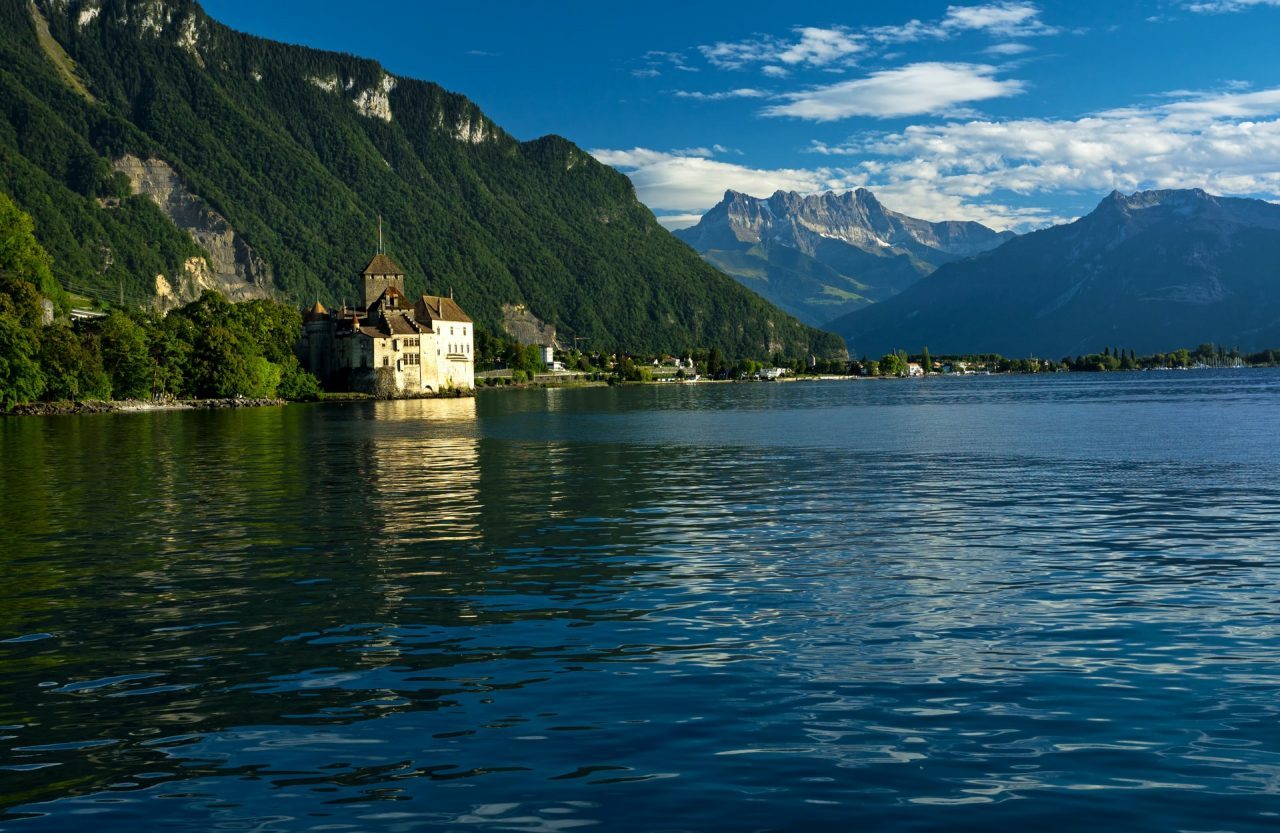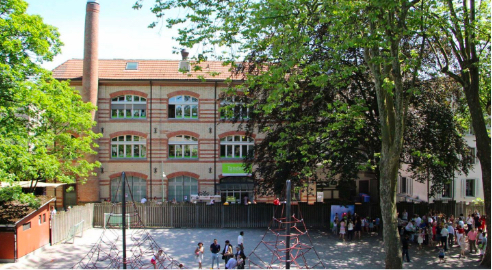There are many ways to discover the beauty of a new place, be it through food, nature, history, architecture, or other fascinating activities. One of the most rewarding experiences is traveling through the splendid countryside of Switzerland. Yet, the impressive number of magnificent castles scattered across the country can overwhelm even the most seasoned traveler.
Switzerland is home to numerous stunning castles, each with its unique history and architecture. Notable mentions include Hallwyl Castle, known for its 800-year history and interactive family-friendly activities; Aarburg Castle, positioned high above the Aare River; the Valère Basilica, a national heritage site with an intriguing blend of castle and church; and the Meggenhorn Castle, famous for its beautiful gardens and panoramic views of Lucerne and the Alps. Whether you’re a history enthusiast, architecture lover, or family traveler, Swiss castles offer a diverse and enriching experience.
With so many majestic chateaus and palaces to choose from, it’s hard to know where to start. That’s why we’ve decided to simplify the process and bring you a list of the top castles in Switzerland every traveler must visit.
Castello di Montebello
Switzerland, known for its picturesque landscapes, punctuated by snow-capped mountains and serene lakes, is also home to a rich tapestry of history. Nestled among this are majestic castles, with one standing out for its unique architecture and significant past, the Castello di Montebello.
Located in the Italian-speaking canton of Ticino, in the charming city of Bellinzona, Castello di Montebello holds a grand stance. This castle is the middle of the three castles of Bellinzona – Castelgrande, Castello di Montebello, and Castello di Sasso Corbaro – and is a part of the UNESCO World Heritage site recognized in 2000.
The history of the Castello di Montebello traces back to the 13th century, but it was later expanded and fortified over the centuries. Its strategic location and robust fortification made it a key defensive structure during medieval times. Its battlements, towers, and massive stone walls reveal tales of olden times, making it an intriguing destination for history buffs and architecture enthusiasts alike.
The architectural design of Castello di Montebello is indeed a spectacle in its own right. It is an example of late medieval military architecture, where the ramparts follow the contour of the hill, creating a fascinating mix of straight and curved walls. The castle itself is structured around an irregularly shaped central courtyard, giving it an idiosyncratic layout that invites exploration.
Today, within its towering walls, the castle houses the Civic and Archaeological Museum. Here, visitors can traverse through the annals of time and experience the region’s history from the Neolithic period to the present day. This extensive collection is not just informative but also fascinating, making your journey through time memorable.
While you are there, don’t miss the breathtaking panoramic view of the city and surrounding Alps from the castle walls. This, coupled with the surrounding vineyards and the distant murmur of the Ticino River, make Castello di Montebello an aesthetic marvel as much as it is a historical gem.
From the moment you walk through the stone gates of Castello di Montebello, you are whisked away on a journey back in time. The age-old stones whisper stories of historical sagas, while the scenic beauty enthralls you. This castle is undoubtedly a must-visit for anyone exploring the best of Swiss heritage.
Whether you’re an enthusiastic history lover or a casual visitor seeking scenic beauty, Castello di Montebello promises a captivating experience, offering a profound journey through Switzerland’s past while basking in its picturesque present.
Chateau de Chillon
[SEE MAP]
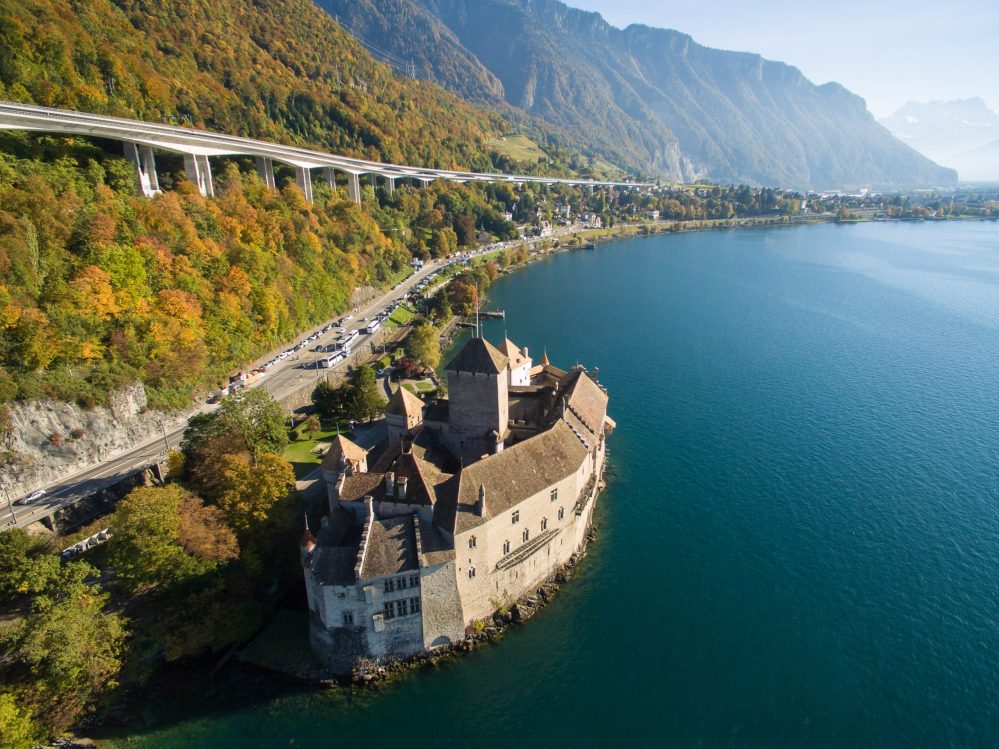 Hailed as one of the most spectacular castles in Europe, Château de Chillon impresses visitors with its medieval splendor, commanding lakeside location, and history that dates back to the 13th century. Its role as a place of imprisonment during the Middle Ages makes it an unforgettable destination.
Hailed as one of the most spectacular castles in Europe, Château de Chillon impresses visitors with its medieval splendor, commanding lakeside location, and history that dates back to the 13th century. Its role as a place of imprisonment during the Middle Ages makes it an unforgettable destination.
It’s like traveling back in time when you visit Chillon Castle! Each room reveals a new layer of history about this castle on the shores of Lake Geneva.
Chillon Castle contains roughly 300 artifacts on display as an outstanding heritage monument. Excluding the furniture, weaponry, and armor, all artifacts displayed here were discovered during the archaeological excavations conducted around the castle from 1896 to 1903.
Aigle Castle
The wonder of Switzerland’s scenic beauty is complemented by the historic richness embedded in its enchanting castles. Among the array of impressive structures, Aigle Castle, or Château d’Aigle, brings a unique blend of historical importance and contemporary indulgence that visitors find captivating.
Aigle Castle sits at the heart of the Swiss Alps, in the charming town of Aigle, in the Vaud canton. The castle’s strategic location at the entrance to the Rhône Valley offers it a panoramic view of the surrounding vineyards, nestled against the backdrop of towering Alpine peaks.
The history of Aigle Castle dates back to the 12th century when it was initially built as a fortress. Over the centuries, it was reconstructed and refurbished by various occupants, including the House of Savoy and the Bernese. Today, its square keep, rounded towers, and thick walls, nestled amidst a lush vineyard, make it an impressive sight for visitors, with its architecture reflecting a journey through time.
However, what sets Aigle Castle apart is not just its stunning architecture and breathtaking location, but its modern role. Today, the castle serves as the home of the Vine and Wine Museum, a testament to the region’s rich viticultural heritage. Here, the ancient cellars of the castle are used to narrate the story of winemaking, from cultivation to consumption.
Visitors can wander through the interactive exhibitions that provide insights into the art of viticulture, showcasing traditional winemaking equipment, old barrels, and even a tasting room. This unique blend of history and wine culture offers a captivating experience to both the history enthusiast and the wine connoisseur.
A stroll around the castle grounds also reveals the magnificent vineyards that surround the castle. These vineyards belong to the Chablais wine region, renowned for producing some of the finest Swiss white wines from the Chasselas grape. The serene view of these vineyards, with the Alps looming in the background, is a sight to behold, making a visit to Aigle Castle an aesthetic feast for the senses.
Aigle Castle is more than just a historic monument; it is a living museum that beautifully intertwines the past with the present. It presents the perfect harmony between history, nature, and viticulture, embodying the Swiss tradition of preserving heritage while adapting to contemporary culture. For anyone venturing into the heart of Switzerland, a visit to Aigle Castle is a delightful immersion into the region’s past and its enduring passion for winemaking.
Vufflens Castle
Vufflens Castle is one of the most well-known castles in the Morges region. A thirty-minute stroll through the vineyards provides a breathtaking perspective of the castle.
Vufflens is a castle with majestic views of Mont Blanc and the Vufflens-la-Caille Glacier in Switzerland. The castle was built between 1863-and 1866 by an American couple and is situated at 1,485 meters above sea level. Between Dennis and Vufflens-le-Château, a nice 30-minute walk around the vineyards provides a breathtaking view of this majestic castle, the lake, and the Mont-Blanc.
Gruyères Castle
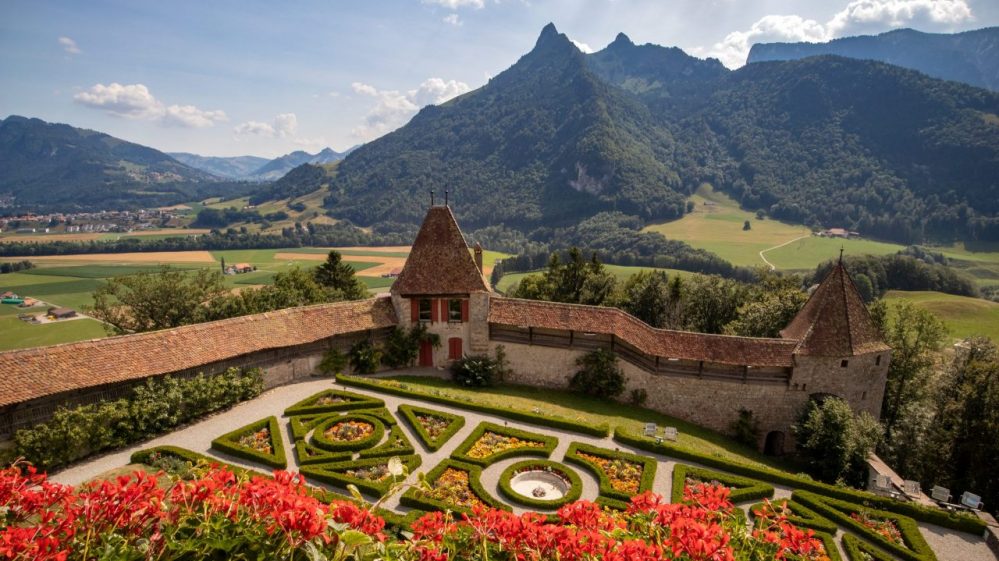 The castle is the major house of one of the leading aristocratic families in western Switzerland throughout the Middle Ages: the counts of Gruyère, as documented in the archives for the very first time in 1244.
The castle is the major house of one of the leading aristocratic families in western Switzerland throughout the Middle Ages: the counts of Gruyère, as documented in the archives for the very first time in 1244.
The castle was built in the 13th century in the shape of a “carré Savoyard,” a military design designed by the House of Savoy, whose vassals are the counts. An almost square enclosure with a keep, a tower, and little overhanging towers at the corners protects it.
Gruyères Castle was owned by the lords who constructed it, the so-called bailiffs of Fribourg, and then the Geneva families of Bovy and Balland before it was repurchased in 1938 by the Canton of Fribourg and then being opened to the public.
Hallwyl Castle
 Hallwyl Castle is one of the most astonishing castles in Switzerland as the moated castle in the canton of Aargau. Eight hundred years of history await you within the walls of Hallwyl Castle, so explore the castle complex and the interactive display of the building and family history.
Hallwyl Castle is one of the most astonishing castles in Switzerland as the moated castle in the canton of Aargau. Eight hundred years of history await you within the walls of Hallwyl Castle, so explore the castle complex and the interactive display of the building and family history.
There are numerous activities offered at the Hallwyl Castle:
- Museum Exhibition
- Workshops and tours for schools
- Workshops and tours for groups
- Events and public guided tours
- Secret corners and puzzles for families
It also offers a bistro with delicacies, and you can even rent rooms for a wedding or other celebrations. The castle is perfect for a family day out, too; adventure playgrounds, gardens, and mini-golf are among the many attractions on offer.
Aarburg Castle
 Aarburg Castle (Festung Aarburg) is a castle in the Swiss canton of Aargau, located in the municipality of Aarburg. It is situated on a steep, rocky mountainside high far above the town of Aarburg. The castle was erected around some medieval castle that functioned as the headquarters of Aarburg Vogt and dominated the narrow-angle of the Aare river.
Aarburg Castle (Festung Aarburg) is a castle in the Swiss canton of Aargau, located in the municipality of Aarburg. It is situated on a steep, rocky mountainside high far above the town of Aarburg. The castle was erected around some medieval castle that functioned as the headquarters of Aarburg Vogt and dominated the narrow-angle of the Aare river.
The fortification has a commanding position over the village of Aarburg and the Aare River. It’s a stunning sight for anyone traveling by vehicle or train, and it’s well worth seeing! Take a stroll to get the most out of the history and folklore surrounding this structure, which is about a thousand years old.
Valère Basilica
The Valere Basilica, also known as the Valere Castle, is a heavily protected church in Sion. It is placed on a hillside and faces the Tourbillon Castle, situated on the opposing hill. It is a national heritage site in Switzerland.
Accompanied by amazing architecture, its central tower is accessed by an interior staircase with its own outer spiral staircase leading to the top. Taking two hours to explore, you’ll walk all over this castle, checking out secret rooms, Gothic chapels, and ghoulish torture chambers.
If you’re looking for an adventurous experience off the beaten track, this is an excellent choice. Don’t forget a pair of comfortable walking shoes, as there are a few steep ways to get up to the parapets. So, take a tour of this stunning building and learn how it was preserved throughout history.
Meggenhorn Castle
The magnificent Meggenhorn Castle is on a bluff above Lake Lucerne’s port, with a spectacular view of Lucerne and the Alps. This castle is easy to find, and once you arrive, you can either park at the entrance and walk to the castle or drive through the gate and stop almost beside it. The image of the castle is covered by a slop as you approach, so when you reach the main door, you’ll be astounded by the gardens and the structure itself.
The Meggenhorn Castle and gardens are located on a peninsula south of Lucerne, on a mountainside. The castle faces a vineyard and is a renowned picnic spot with swimming access to the lake.
You can make your fantasy a reality by hosting your occasion in a unique setting. The exquisite rooms provide the ideal environment for company gatherings, marriages, civil weddings, family festivities, graduation ceremonies, and conferences, with meals and feasts in the ballroom and cocktails on the castle terrace.
Rapperswil Castle
Rapperswil Castle is a popular tourist attraction in the scenic “City of Roses” on the banks of Lake Zurich. The castle, which was built near the end of the middle ages and has been repaired several times, can be seen from a long distance. It stands well above the town, sitting atop the Lindenhof, a steep rocky hill that runs through Rapperswil.
It has a breathtaking view that you would not want to miss, with the yard, walls, and architecture it carries. Here are some things to see if you visit:
- Castle from the 12th-century
- Beautiful scenery over Rapperswil
- Deer park on the castle hill
You can also take your children with you as they can climb walls and play with a speaking tube in a playground located directly beneath the deer park. So, do not forget to mark Rapperswil Castle on your list.
Tarasp Castle
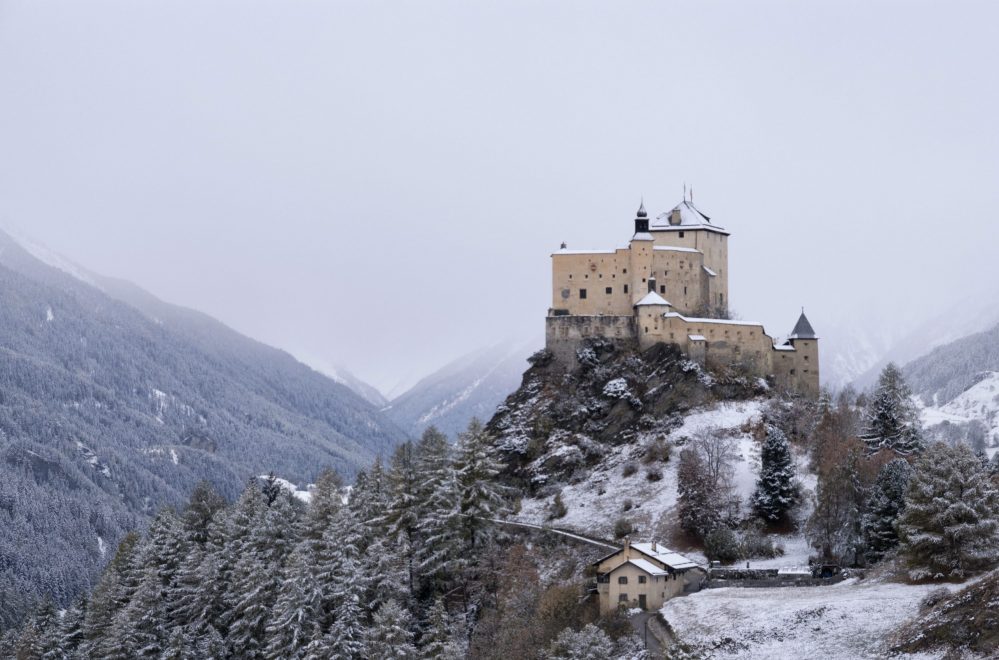 The namesake settlement in Upper Engadine is dominated by Castle Tarasp, which dates from the 11th century. The castle belonged to Austria until 1803 and was often besieged and fought over, although it was never taken. Karl August Lingner, the creator of the mouthwash Odol, saw the vacant and deteriorating castle in 1900, bought it, and had it extensively rebuilt (the restoration lasted until 1916).
The namesake settlement in Upper Engadine is dominated by Castle Tarasp, which dates from the 11th century. The castle belonged to Austria until 1803 and was often besieged and fought over, although it was never taken. Karl August Lingner, the creator of the mouthwash Odol, saw the vacant and deteriorating castle in 1900, bought it, and had it extensively rebuilt (the restoration lasted until 1916).
Castle Tarasp has been available to the public since 1919, and visitors can see nobles’ halls and ballrooms, medieval bedrooms, the castle chapel, and the 2,500-pipe organ. The castle hosts public organ performances, excursions, and “active holidays,” which allow visitors to assist with annual maintenance tasks.
Numerous fun and educational activities await you there, so seize the opportunity.
Grandson Castle
Grandson Castle is Switzerland’s second-largest castle, with a 40-meter-high façade, massive ramparts, and a more than 150-meter-long parapet walk. The fortification is a remarkable example of 13th-century castle architecture and was built by Otto I, Lord of Grandson.
This imposing 13th-14th century Gothic fortress, which overlooks Lake Neuchâtel and was the seat of the noble Waldensian Grandson family, was also at the core of European history during the Burgundy Wars (1474-1477) among Charles the Bold and the Confederates, and the echoes of the Battle of Grandson (1476) still resonate with people in the collective memory of Switzerland.
The Grandson castle has a long history, dating back to roughly 1050, and has been owned by a dozen different people over the centuries, so there is a lot to learn.
Make sure you find time and a place on the list for Grandson Castle, and we promise you will be left amazed and inspired.
Tourbillon Castle
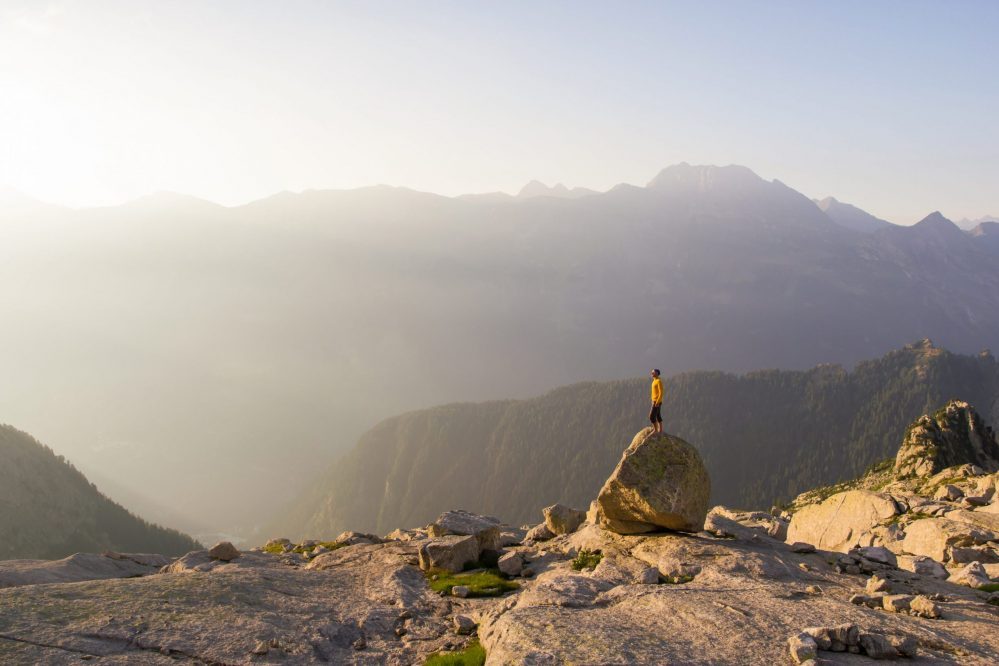 Tourbillon Castle is considered a national historic site in Switzerland. It is encircled by a round wall that reflects the spire’s uneven top. From up there, you can see The Basilique de Valere, which is positioned on the opposite hill.
Tourbillon Castle is considered a national historic site in Switzerland. It is encircled by a round wall that reflects the spire’s uneven top. From up there, you can see The Basilique de Valere, which is positioned on the opposite hill.
In 1788, the castle was destroyed by fire. Despite this, the rectangular keep and a thin watchtower in the corner and many of the internal walls still remained.
To get to the location, you’ll have to ascend steep stairs that wound their way around the hill. The walk will be totally worth it when you experience the panoramic view from above.
Montebello Castle
The Bellinzona Castles are a collection of fortifications surrounding Bellinzona’s town. The complex, located in the Alpine foothills, is made up of a fortified city and three castles: Castelgrande, Montebello, and Sasso Corbaro. Since 2000, the defensive walls of Bellinzona’s castles have been designated as a UNESCO World Heritage Site.
The castle was once known as Montebello Castle or Castel Piccolo (“little castle”) (1457-1472). It was renamed Svitto Castle under the Swiss occupation and San Martino Castle after 1818.
Moreover, outside you can enjoy a relaxing picnic and some healthy fun in our well-equipped playground or snap a snapshot at the Grand Tour of Switzerland photo site.
Also, the scenery from this fortress is breathtaking! It’s a short walk from Piazza Collegiata and the Nocca neighborhood, so do not miss out.
Thun Castle
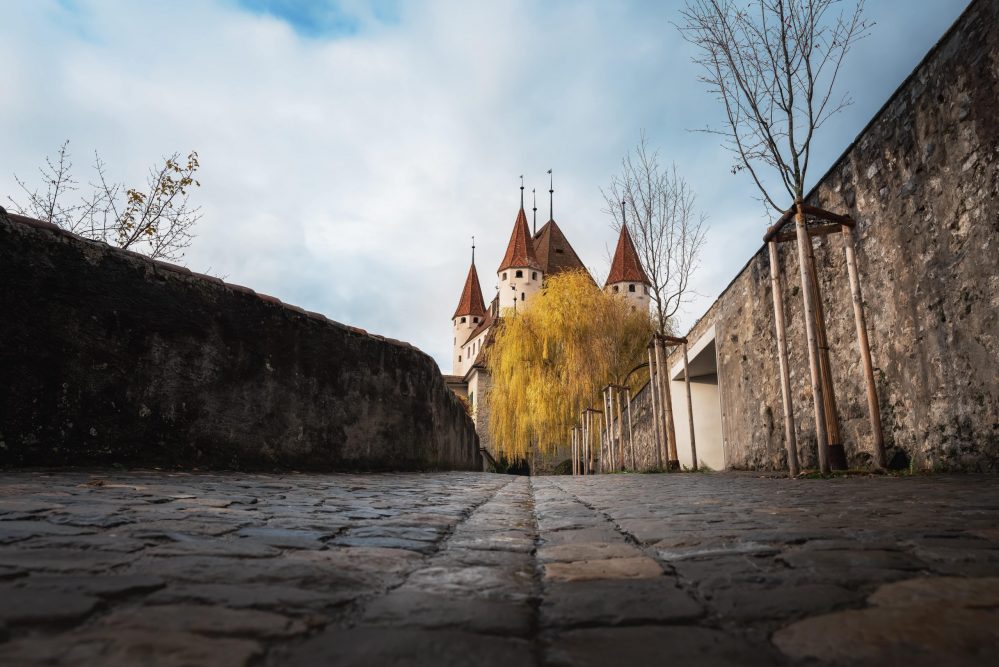 The old castle on the outskirts of Thun is a remarkable focal point of Bernese Oberland’s entry. The Knights’ Hall, one of the very few surviving chambers of its type dating from the Middle Ages, is housed in this nearly entirely intact emblem of power.
The old castle on the outskirts of Thun is a remarkable focal point of Bernese Oberland’s entry. The Knights’ Hall, one of the very few surviving chambers of its type dating from the Middle Ages, is housed in this nearly entirely intact emblem of power.
Since the 12th century, Thun Castle has been a magnificent icon closely tied with the town of Thun. The vistas of the surrounding Alps, Lake Thun, and the old town alone make it worthwhile to visit.
Please keep the following in mind to guarantee that your trip is ideal in every way:
- Check the current work hours ahead of time.
- Make a reservation for a castle tour in advance.
- Before visiting, wheelchair users should inquire about access points.
Oberhofen Castle
On the edge of Lake Thun sits Oberhofen Castle, which has a medieval keep and a lake tower. The living museum is housed in the palace, which goes back to the early thirteenth century. The enormous castle park is said to be among the most beautiful in the Alps region.
The exhibit rooms of the living museum illustrate Bernese residential culture from the 16th to the 19th century, with artifacts varying from neo-Gothic dining rooms and knights’ suits of armor to a Turkish smoking parlor. The castle chapel, with its late 15th-century wall paintings, is still used for baptisms and marriages today.
Besides the interesting history and beautiful architecture, you can:
- Rent a room in the castle
- Enjoy the magnificent park in the alpine region
- Immerse yourself in the past that has shaped the castle over eight centuries
- Experience the cultural tours
Ensure you check out at least one of the above.
Spiez Castle
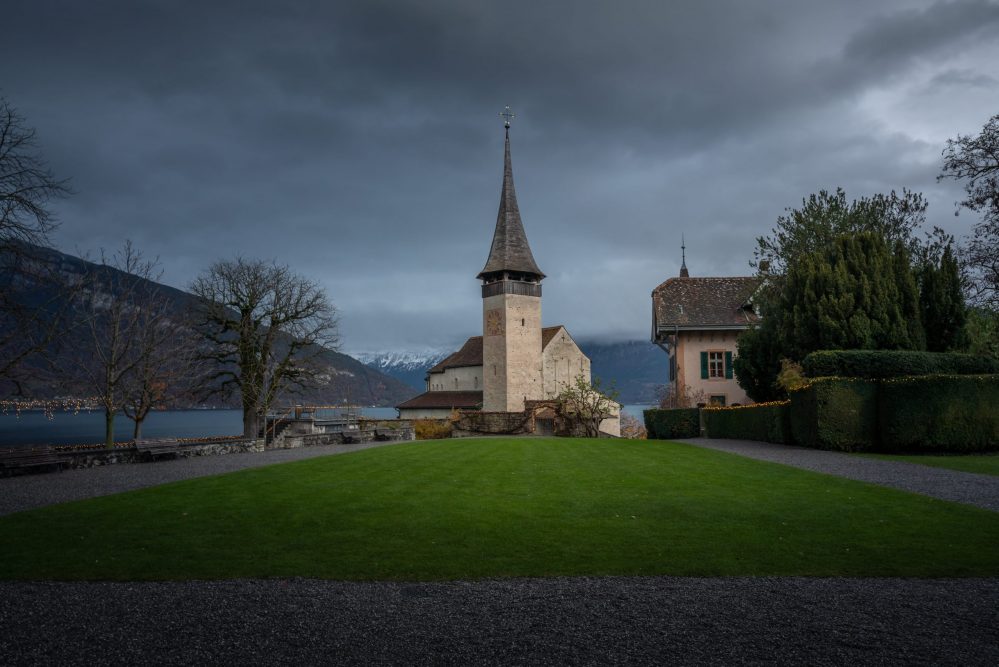 In what is said to be Europe’s most beautiful bay, Spiez Castle is encircled by vineyards and the Alps. From the castle tower, you can enjoy spectacular views of Lake Thun and the Bernese Oberland Alps, or you can visit the castle museum’s permanent exhibition or one of the attractive special exhibitions.
In what is said to be Europe’s most beautiful bay, Spiez Castle is encircled by vineyards and the Alps. From the castle tower, you can enjoy spectacular views of Lake Thun and the Bernese Oberland Alps, or you can visit the castle museum’s permanent exhibition or one of the attractive special exhibitions.
By visiting Spiez Castle, you may learn about the castle’s 1,300-year history. In the historical exhibition halls, the personal life story of the warrior Adrian von Bubenberg, who previously dwelt in Spiez Castle, is told.
With beautiful views, relaxing vibes, and enriched stories, you can enjoy your time with your loved ones in the middle of history. Pick up the phone and call for a reservation.
Bottom Line
In this comprehensive guide, we’ve highlighted the marvels of Switzerland’s most captivating castles, each presenting a unique chapter from the rich tapestry of the country’s history and cultural heritage. Every castle on our list is a treasure trove of experiences, offering distinct insights into Switzerland’s fascinating past.
While each castle in Switzerland is a must-see, their individual charm and diversity ensure that every visitor will find something new and engaging, even if they’ve previously toured other castles. So, whether you’re a seasoned explorer or planning your first Swiss adventure, this guide is a key resource to help you chart your course.
We invite you to immerse yourself in the mesmerizing architecture, enchanting landscapes, and centuries-old stories that these castles have preserved. Embark on your Swiss journey, soak in the grandeur of these cultural landmarks, and let the spellbinding beauty of Switzerland leave you inspired and awestruck.
FAQs
Q1: What is the best time to visit these Swiss castles?
A1: While Switzerland is beautiful all year round, the ideal time to visit Swiss castles might be in the spring or summer when the weather is more temperate. However, some castles may have special winter events or tours that might be worth experiencing.
Q2: Can I visit multiple castles in one day?
A2: Depending on their proximity to one another and your pace, it may be possible to visit more than one castle in a day. However, to truly appreciate the history and beauty of each site, it might be best to limit your visits to one or two castles per day.
Q3: Are there guided tours available at these castles?
A3: Most castles in Switzerland offer guided tours, either as part of the entrance fee or for an additional cost. It’s always a good idea to check the castle’s official website or contact them directly for the most accurate and up-to-date information.
Q4: Are these castles accessible for individuals with mobility issues?
A4: While some castles have made efforts to increase accessibility, others might be challenging due to their historical design with steep stairs and narrow passages. We recommend checking directly with each castle for information on accessibility.
Q5: Can I host events at these castles?
A5: Some of the castles do offer facilities for special events like weddings, parties, or corporate gatherings. It’s best to get in touch with the castle management to learn about the specific services they provide.

